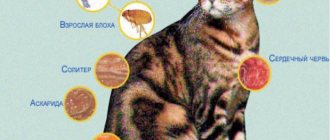Save the article:
It happens that a beloved pet receives a gift from nature of neighbors in the body - worms. Not the most pleasant neighborhood, from which the animal’s body will suffer for a long time if the owner does not undertake deworming. Worms in a cat are a serious disease that depresses all systems of the body: the animal loses weight, eats poorly, and becomes very tired.
Where does such a misfortune come from? Such unkind guests easily enter the body, but leave with reluctance. If you suspect unwanted neighbors, it is better to visit the veterinarian and find out who decided to destroy the cat from the inside.
Types of worms in cats and cats
Worms in cats come in different sizes and shapes, and they feed and reproduce differently. They have long been classified into three categories: flukes, tapeworms, and roundworms. Let's study the enemy!
| Name | Peculiarities | Symptoms in a cat |
| Lungworms | This infection enters the cat if it drinks from a dirty source or eats crustaceans. Tapeworms destroy the lungs with cyst-like formations |
|
| Cucumber tapeworm | The parasite can easily take up residence in both the cat’s body and the human body. In a cat, the size of a tapeworm rarely exceeds a length of 30 cm. The danger is expressed by damage to the intestinal walls. The parasite can be brought by fleas and lice eaters. | The pet is vomiting, losing weight, and is irritable. My stomach is constantly rumbling and I have diarrhea. |
| Wide tapeworm | The parasite grows in the body up to 1.5 meters in an animal, and up to 12 meters in a person. You can become infected by eating raw fish, crustaceans and drinking river water. |
|
| Liver fluke | The fluke has chosen the liver as its home and does not disdain the pancreas and gall bladder. To acquire such a neighbor, you can eat raw fish. | The vomit is colored in shades of yellow, there is no appetite, the animal is weakened. Diarrhea appears and the temperature may rise. Complex treatment is used here, due to the ineffectiveness of standard treatment. |
| Causative agents of alveococcosis | The parasite reaches a length of 4-5 mm and does not pose a danger to the cat. For many years this neighborhood has been quite peaceful, but as soon as a person becomes infected, trouble will strike. It is difficult to make a diagnosis; the patient faces death due to metastases to various organs, and a liver tumor develops. The worm can enter the body as a result of eating a rodent. | There are no symptoms. |
| Toxocars | The localization of five-centimeter helminths is the esophagus, gall bladder and liver. The source of infection is food, and cases of intrauterine infection are also known. The parasite is dangerous for kittens, as the rapid development of toxocara begins, which is fraught with ruptures in the small intestine. | No symptoms observed |
| Hookworms | The size of these guests of the cat’s body does not exceed 1 cm. Hookworms choose the intestines as their place of residence, and blood as their source of nutrition. Helminth eggs can enter the body with food, and the larvae can even penetrate the skin of a pet. | Appetite is reduced, the animal is lethargic and apathetic to everything. The stool is liquid and there is visible blood in it. The cat is vomiting and coughing a lot. |
These are the main parasitic creatures that can seriously complicate the life of a pet and its owner.
Routes of infection and localization in the body
There are three categories of helminths: round , tape and flat flukes . They have different life cycles, habitats and routes of entry into the body of cats.
Round, or nematodes
The following representatives of this species are more common in cats:
- Roundworms and toxacara are considered typical cat worms. Adults grow up to 3–5 cm in length, less often 10 cm, live and reproduce in the small intestine. Eggs are released into the environment with feces, and reach mammals with contaminated soil, street dust or water. The larvae form in the intestine, pass through its walls, enter the blood vessels, and spread throughout the body. Then they ripen in the lungs, from where they exit through the respiratory tract with sputum. The animal swallows some of it again, and they return to the intestines.
- Hookworms do not exceed 2 mm in size, are able to penetrate the body through the skin, and affect the intestines.
- Heartworms , or heartworms . Eggs are transferred by mosquitoes from sick animals to healthy ones. Mature individuals live in the lungs, muscles, heart, and blood vessels.
Tape or cestodes
Helminths of this variety live in the intestines and attach to the walls with hooks. You can only become infected with larvae that mature in the body of intermediate hosts; the eggs are not dangerous.
The following cestodes are most often parasitized on cats:
- The cucumber tapeworm reaches a length of 0.1 to 0.7 meters, consists of a head and segments where the eggs mature. Individual segments come out with feces, the eggs are freed from the shell and penetrate the body of the fleas. A cat becomes infected if it swallows an insect with a larva.
- The broad tapeworm is similar to a tapeworm, but its temporary hosts are freshwater fish and crustaceans. Mammals become infected with tapeworm through river water and thermally untreated fish.
- Alveococci and echinococci are no larger than 4 mm in size; temporary carriers are rodents and rabbits. For cats, these helminths pose an increased danger because they become both final hosts and intermediate hosts. Adult worms live in the intestines. The larvae penetrate the liver, brain, eyes and other organs.
Flukes, or trematodes
Representatives of this species are less common, but pose a mortal danger. They attach to organs with suction cups, feed on tissues, damage and destroy.
Trematodes found in cats include:
- Opisthorchis, or cat fluke , 5 mm - 1.5 cm long, affects the gallbladder and ducts, the liver. The life cycle of parasites is complex; before maturation, they exchange two intermediate carriers. First they enter the body of freshwater mollusks - slugs, snails, then fish. A cat becomes the definitive host when it eats raw fish infected with trematodes.
- Paragonimus, or pulmonary fluke , spreads in the same way as opisthorchid; affects the lungs.
The complex development cycle excludes human infection with trematodes directly from a cat. Pets run the same risk of contracting worms as street animals: nematode eggs enter the apartment on the soles of their owners’ shoes, cestode larvae and flukes enter the apartment with undercooked fish.
Is it possible to get worms from a cat?
global $ads_google;
//data-ad-slot=”2475549904″ $ads_google = empty($ads_google) ? false : true; ?> if ($ads_google == false) {?> $ads_google = true; ?> } ?> There are approximately 32 known varieties of worms in cats , which will not deny themselves the pleasure of settling in the human body. The consequences of such proximity in animals and humans can manifest themselves differently. If a pet’s body can calmly coexist with some types of helminths, then in some cases the consequences for humans are serious.
Infection occurs after the eggs or larvae of worms enter the oral cavity. Basically, they get there through the hands. Even if several hours have passed after contact with the pet, parasite eggs remain on the hands. A cat, licking its fur, spreads pathogens through it from its anus, where the larvae and eggs of helminths accumulate. A person pets a furry friend, forgets to wash his hands with soap, and soon finds out that he has new little “friends” in himself.
Worms are transmitted not only from direct contact with the cat, but also through his things and litter box.
Worms dangerous to humans
Let's look at helminths that are transmitted from cats to humans and are dangerous:
- Flatworms cause a disease called opisthorchiasis. The parasite settles in the liver, gall bladder and pancreas, affecting the ducts of these organs. You can get sick by eating raw or poorly cooked fish, mainly from the carp family;
- The wide tapeworm of the cestodoses group causes diphyllobothriasis. The worm occupies the small intestine and grows up to 10 meters. Iron deficiency anemia and dyspeptic disorders gradually develop. Raw freshwater fish can also become a source of infection;
- Echinococcus in the larval stage can seriously affect the internal organs of a person. Cats also carry the dangerous disease alveococcosis to humans. Contact with a sick animal can be fatal for people.
Hygiene remains the main barrier to the transmission of such diseases.
The first symptoms of opisthorchiasis
The first signs appear when the protective function of the immune system decreases. In the early stages, the patient experiences the appearance of general weakness and sweating increases. The acute form of opisthorchiasis manifests itself as follows:
- the appearance of insomnia and nervousness;
- pain in the right hypochondrium;
- pain in the back and abdomen;
- presence of asthmatic bronchitis;
- feeling of body aches and fever;
- the appearance of allergic rashes on the skin;
- the presence of flatulence, nausea, vomiting, abdominal pain, general discomfort;
- a sharp decrease in appetite, too liquid stool consistency.
When examining the body, the doctor may detect an enlarged liver and an increased number of eosinophils in a general blood test.
Symptoms of opisthorchiasis in adults are somewhat different from the first signs of children. In little fidgets, the disease is expressed in the manifestation of persistent allergosis, intoxication of the whole body and an immunosuppressive state. The temperature may also rise and last up to 2-3 weeks.
Symptoms in women are most pronounced during the menstrual cycle. If a woman has a parasite in her liver, her periods become very painful and her cycle becomes unstable.
Signs of worms in a cat
Worm infestations do not manifest themselves immediately: the development of symptoms is directly proportional to the amount of infection in the body.
Symptoms of worms in cats include a number of signs:
- depressed and apathetic state;
- problems with appetite;
- weight loss;
- fatigue;
- slow development in kittens;
- unusual condition of the coat, its disheveled appearance;
- noticeable yellowness of the mucous membranes;
- on palpation there is noticeable enlargement of the liver (trematodes);
- anemia of the mucous membranes (cestodia);
- constipation gives way to diarrhea, vomiting;
- cough;
- frequent licking of the anus due to itching;
- intoxication in the form of convulsions, paresis of the limbs;
- premature birth and sometimes miscarriage;
- blood in stool.
The list is quite large, symptoms do not appear individually, they are a whole set of signs.
Prevention
Comprehensive prevention of nematodes in cats can reduce the risk of infection. The pet, regardless of whether it is outside or not, needs to be given anthelmintic drugs once every 3 months. Even if cats do not have helminths, such a remedy will not harm them.
To reduce the risk of infection, it is recommended to vaccinate your cat promptly. It is necessary to exclude raw fish and meat from entering the animal’s diet. All food must be thermally processed. The water that the cat will drink must be boiled in advance.
It is advisable to protect your pet from going outside and from contact with wild animals. It is necessary to carry out disinfection with special means once every 3 months, using them to treat all the cat’s equipment, incl. sleeping place, scratching posts, etc. In addition, it is necessary to regularly clean the premises using bleach.
All information posted on the site is provided in accordance with the User Agreement and is not a direct instruction to action. We strongly recommend that before using any product, you must obtain a face-to-face consultation at an accredited veterinary clinic.
Treatment of worms in cats
Anthelmintic treatment is prescribed by a veterinarian after testing. It is required to accurately identify the enemy and locate the source of the lesion.
Why is it necessary to consult a veterinarian? Because each anthelmintic medication acts on one type of parasite, and it is not so easy to remove worms from a cat But there are also complex drugs that act on a certain number of helminths.
The treatment regimen is simple: the drug for worms is given once in the morning, then the dose is repeated after 10 days. Deworming is also carried out 10 days before vaccination. Cats are dewormed 2-3 weeks before and 3 weeks after birth.
Remedies for worms in cats
global $ads_google;
//data-ad-slot=”2475549904″ $ads_google = empty($ads_google) ? false : true; ?> if ($ads_google == false) {?> $ads_google = true; ?> } ?> If you suspect that your cat has worms, then you need to study the list of means that can be used to deworm the animal. These are effective medications in many cases.
If the question arises about what to give your cat for worms , then veterinary pharmacies can offer tablets, suspensions and injections. There are two types of tablets: narrow-profile and complex. Narrow-profile drugs act against a specific parasite; therefore, complex drugs are effective against several helminths.
Deworming tablets for cats
Effective medications for worms include:
- sugar cubes (Polivercan) at a price of up to 50 rubles per piece;
- Kanikvantel tablet, which can be bought for 55-65 rubles;
- Drontal with a price of up to 70 rubles;
- Milbemax, which is sold in the form of two tablets from 350 rubles;
- Dirafen (35-100 rubles per package);
- Alben (35-75 rubles per package).
Sugar cubes are convenient to use - they dissolve easily in water, and the cat willingly drinks the medicine through a syringe. To properly give a pill to a cat, you need to know how to do it. Otherwise, the drug will enter the body in the wrong dosage or not at all.
Anti-worm suspension for cats
Suspensions are also used to remove worms from cats. They are given to the animal orally using a dispensing syringe.
The list of excellent effective suspensions includes the following drugs:
- Dirofen (150-180 rubles);
- Prazicide for adult cats or kittens (140-150 rubles);
- Pyrantel (in suspension, from 50 to 60 rubles);
- Prazitel (120-145 rubles).
It is easier to give the suspension to the animal, its taste is pleasant, and the cat will not protest as much as when administering a bitter tablet. Suspensions are prescribed to kittens from three months of age. Admission is carried out strictly according to the dosage indicated on the package. 6 hours after administration, the pussy is given activated charcoal to prevent the development of intoxication.
Deworming drops for cats
Drops are a convenient remedy for deworming in cats , which also act on fleas, lice and ticks.
Popular anthelmintic drops:
- Stronggold (from 200 rubles);
- Lawyer (1100 rubles);
- Profender (450 rubles);
- Dironet (from 320 to 350 rubles).
Since the drops are applied to the withers, there is no chance that the animal will lick them and become poisoned.
Deworming injections for cats
global $ads_google;
//data-ad-slot=”2475549904″ $ads_google = empty($ads_google) ? false : true; ?> if ($ads_google == false) {?> $ads_google = true; ?> } ?> Cats can be treated for helminths at home not only with tablets, drops or suspensions. Injections against worms also work quickly.
Veterinarians usually prescribe the following medications:
- Novomek (50-70 rubles);
- Ivomek (150-200 rubles);
- Barmek.
Injections are not used without consultation with a specialist.
Diagnosis
Diagnosis is based on the detection of fragments of parasite bodies in feces . In addition, diagnosis is possible based on the detection of eggs in stool analysis. In the cucumber tapeworm, the segments resemble white cucumber seeds; in other types of cestodes, the body segments are more similar in shape to small rectangles.
Note that the segments have a shape that is sufficiently characteristic for making a diagnosis and clarifying the type of parasite, exclusively in a fresh state. When dry, they wrinkle, which complicates the “identification” process.
In these cases, dried tapeworm segments can be rehydrated in saline. Simply put, the dried segment is placed in a warm liquid, after which it is saturated with moisture and straightens out again, becoming a good material for microscopic examination.
Why is segment research so important? The fact is that in many cestodes the eggs are released exclusively by segments that have entered the external environment. To put it simply, there are either no eggs in the feces, or there are so few eggs there that examining the feces will not yield anything in any case.
How to give a cat a deworming tablet
Giving a cat a pill is not an easy task. No matter how hard you try to persuade the animal to open its mouth and swallow the “delicacy,” there will be no result. There is a standard algorithm of actions that will help feed a cat a medicinal drug.
It is best to crush the tablet into powder and roll it into a ball with a tasty treat, sit the animal with its back to you and unclench its jaws. The medicinal ball is stuffed into the pet’s mouth and closed, stroking the pussy’s throat. As soon as the swallowing movement is made, you need to make sure that the medication is swallowed.
There are other ways to give your cat the pill.
If a pregnant cat has worms
If a cat is pregnant, the owner will clearly be concerned about the health of the expectant mother and her offspring. For this purpose, preventive measures are carried out three weeks before mating, treating both the groom, if necessary, and the bride. However, if the pussy is preparing to become a mother and has managed to catch helminths, then you need to check with the veterinarian what treatment is appropriate to prescribe based on the test results. There are anthelmintic drugs that have no contraindications for pregnant cats, but there are instructions for taking medications regarding the period. Some medications for cat worms are indicated for the initial stage of pregnancy, and some can be taken in the last weeks.
Stages of acute opisthorchiasis
When it comes to acute opisthorchiasis, it is divided into 4 classes.
- Typhoid-like course - there are symptoms of pancreatitis, jaundice and hepatitis, an enlarged liver, gastritis, eosinophils in the blood up to 90%.
- Hepatocholangetic type - pancreatitis, aching abdominal pain, the liver is affected, the function of the pancreas is impaired.
- Gastroenterological – the presence of enterocolitis, stomach ulcers, erosive gastritis, stool disorders are observed.
- Damage to the respiratory tract - the presence of asthmatic-type bronchitis, pleurisy and pneumonia.










